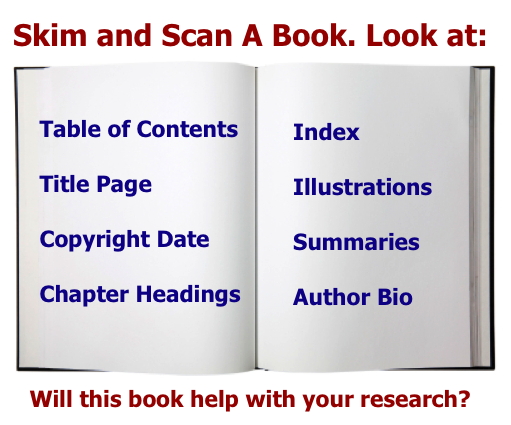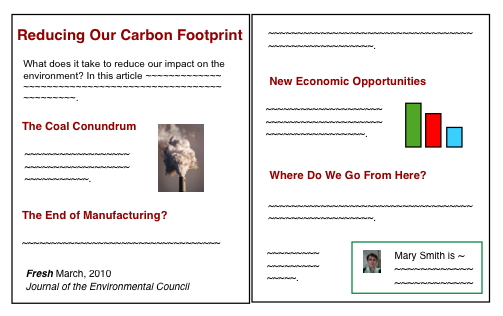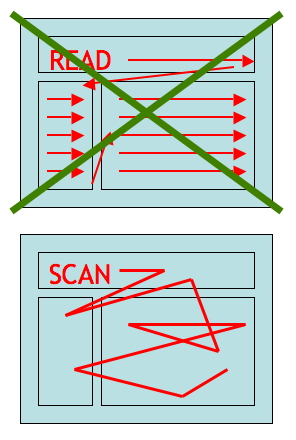First determine whether the resource you are considering is the best for you.
Skim and Scan
Skimming and Scanning a resource will give you an overview of its content, and help you to determine whether it is relevant to your research, and to what extent.

Skimming and Scanning Books
Look at the:
- Table of Contents: The Table of Contents outlines all of the major topics covered in the book
- Title Page: Gives you information about the focus of the book
- Copyright Date (usually on back of title page): Is the information current enough for your topic and assignment?
- Chapter Headings and Sub-Headings: If the Table of Contents looks promising, scan through chapters of particular relevance to see how deeply the topic is covered.
- Index: Look for specific topics and/or terms that are relevant to your topic.
- Illustrations: Photographs, drawings, charts, statistics, diagrams – all of these elements can contribute greatly to your understanding of the topic. Are there useful illustrations in the book? Do they contribute to your understanding?
- Summaries: Some books have chapter or section summaries that might prove useful to help you determine whether the deeper content will be useful for your research.
- Author Biography: What are the author’s credentials? Does he/she have the expertise on the topic to make this book a credible source?
Skimming and Scanning Articles
In articles from popular journals and magazines, look at the:

- Title and Subtitle: How closely does this article seem to relate to your topic?
- Publication: What is the name of the magazine or journal? Is it a reputable publication? If it is the journal of a particular organization, does that organization represent a particular point of view or have a particular bias about the topic?
- Publication Date: We frequently use articles to understand current perspectives on the topic. Is this article current enough to be relevant for your research?
- Author: What are the writer’s credentials? Many articles include a brief biography of the author that might help you make this determination.
- Summary: Many articles include a brief summary, often placed before the main article. This may help clarify the title and give you a better idea of the article’s focus.
- Sub-Headings: Articles usually have many sub-headings. These will help you zero in on specific areas of interest.
- Illustrations: Photographs, drawings, charts, statistics, diagrams – all of these elements can contribute greatly to your understanding of the topic. Are there useful illustrations in the article? Do they contribute to your understanding?
For articles from scholarly or academic journals, look at all of the areas suggested above. Also consider:
- Abstract: Scholarly articles include an abstract. The abstract concisely describes the problem being examined, the methodology of the study and the conclusions reached. This is most useful when determining whether the article will help you with your own research.
- Introduction: The introduction gives an overview of the problem the study hopes to examine.
- Discussion: The discussion looks at the researchers’ overall findings: what they found, what they found surprising, and what they think requires further study.
- Conclusion: The conclusion summarizes the findings of the research.
- References: The reference list may suggest other articles that might be useful for your research.

Skimming and Scanning a Webpage
Webpages are built for skimming and scanning. They are very visual: We do not read the web from top to bottom and left to right – we scan the page for relevant data and pathways to further information.
As you skim and scan the webpage, look for:
- Site Menu: Assess whether the main areas of the site reflect your research interests.
- Illustrations: Are the illustrations relevant? Do they add to the value of the information?
- Author and Organization: Who publishes this website? Are they reliable? Are they impartial? Does the sponsoring organization represent a particular point of view or bias about the issue?
- Last Update: When was the site last updated? Is the information current?
Remember, when using the Internet you are the filter: you need to take extra care in assessing the validity of the site. Find out more on the Evaluating Websites page.
Reading non-fiction texts means being aware of how language is used. Find out more about sorting through flowery language to get at the basic facts on the Are These My Own Words page of this site.
Find Out More
University of Toronto Writing Centre: How to Get the Most Out of Reading
